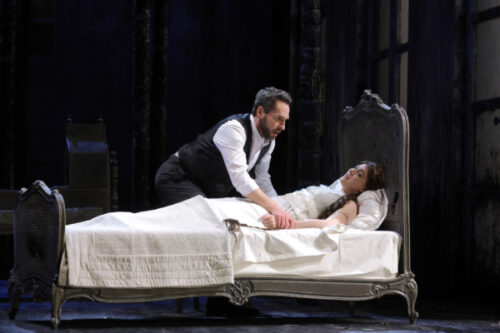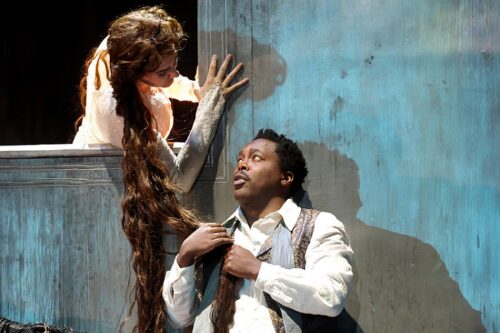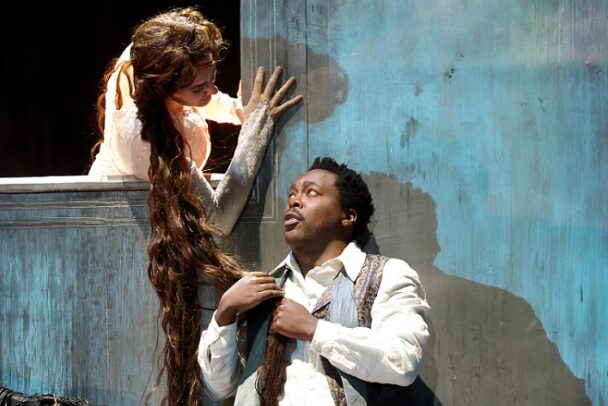 United States Debussy, Pelléas and Mélisande: Soloists, Chorus and Orchestra of LA Opera / James Conlon (conductor). Dorothy Chandler Pavilion, Los Angeles, 2.4.2023. (JRo)
United States Debussy, Pelléas and Mélisande: Soloists, Chorus and Orchestra of LA Opera / James Conlon (conductor). Dorothy Chandler Pavilion, Los Angeles, 2.4.2023. (JRo)

Production:
Production – Sir David McVicar
Stage direction – Leah Hausman
Sets and Costumes – Rae Smith
Lighting – Paule Constable
Projection – Jack Henry James Fox
Chorus director – Jeremy Frank
Cast:
Pelléas – Will Liverman
Mélisande – Sydney Mancasola
Golaud – Kyle Ketelsen
Geneviève – Susan Graham
King Arkel – Ferrucio Furlanetto
Yniold – Kai Edgar
Physician – Patrick Blackwell
Shepherd – Kyle Ketelsen (offstage)
The orchestra in Debussy’s singular opera, Pelléas and Mélisande, is a character in its own right. From the dense forests, deep caverns and churning seas to the setting sun, stars at midnight and birds in flight, the music personifies nature. The LA Opera Orchestra embodied the shimmering beauty of the score, led with incomparable artistry by James Conlon. Lights and darks and all shades in between existed in perfect balance. Even the smell of the sea and the perfume of flowers was a felt presence.
Maurice Maeterlink’s play was the perfect vehicle for the composer and, aside from cutting a few sections, Debussy used the text word-for-word. With its fraught symbolism and mysterious atmosphere, the play’s concerns harmonized with Debussy’s impressionistic tribute to the natural world. It’s as if the faun of L’Après-midi d’un faune darted into the forests of Allemonde.
And though nature is aroused to fury in this tragic love triangle, it is an intimate affair – a tale of innocents caught in the inexorable flow of fate. Conlon and the orchestra were able to capture both the intimacy and the expansiveness of Debussy’s music, and it was breathtaking.
Mélisande represents the idea of an otherworldly maiden – an unpossessable creature of nature. Where does she come from? What is she running from when Golaud, prince of Allemonde, sees her in the forest? Golaud never finds out, nor do we. It is the game of guesswork that renders her and the plot endlessly intriguing. She could be Melusine, the water spirit of French folklore, or a fairy-tale figure: the beauty who runs from the beast, the selkie who sheds her skin, the mermaid who gives up her watery home to walk on legs. She is even Rapunzel with her long hair cascading from the tower. In ballet, with its ideal of the ethereal sprite, look no further than the Sylphide, the Firebird, Odette or Ondine.

Sydney Mancasola’s Mélisande was a shining presence. A versatile soprano, her voice was the perfect instrument for the heroine’s quiet phrases and rising passion. With a naturalness of expression, she brought sweetness and clarity to her singing which focused the drama, setting in motion the ensuing twists and turns of the plot.
When Golaud finds Mélisande by a well in the forest, he is enchanted and marries her, returning to his family with his bride six months later. His younger half-brother, Pelléas, falls in love with her, and it is a fatal attraction, culminating in his and Mélisande’s death.
The charismatic Kyle Ketelsen sang the role of Golaud, a man tormented by jealousy. His nuanced performance illuminated the plot – creating a character that was all ego in contrast to Mélisande’s self-effacing innocence. Golaud has the most extreme character arc in the story. Ketelsen’s smooth baritone accommodated the transition from his self-possession in Act I to the mounting rage that followed in Act IV, Scene 2, when he dragged his wife by the hair, and on to the harrowing climax – the murder of his brother.
Will Liverman, a gifted singer, famed for creating the role of Charles in Terence Blanchard’s Fire Shut Up in My Bones, was less believable as Pelléas. Liverman’s passion rose too early, his singing more declamatory in the tradition of Italian grand opera. Pelléas’s relationship with Mélisande is marked by child-like simplicity. It wasn’t until the couple declared their love in Act IV that Liverman’s interpretation merged with the role, and his performance resonated.
The David McVicar production from the Scottish Opera was set during Debussy’s time. Except for Mélisande, the clothing was late Victorian – a reasonable decision. Fortunately, Rae Smith’s costume designs for Mélisande appeared to draw on the Pre-Raphaelite art of the period with its Gothic sensibility: her wardrobe of flowing dresses was a fitting style for a fairy-tale heroine. The sets were appropriately gloomy – large, rusted panels to create rooms; tall, gnarled posts for trees. Paule Constable’s lighting offered visual clues to the time of day, and the inventive use of darkened curtains to close each scene added a cinematic quality.
What was utterly perplexing in this production was the opera’s opening scene. Instead of discovering Mélisande in the forest, Golaud finds her lying flat on her back on a bed inside the castle. Since she dies in her bed at the opera’s conclusion, has McVicar conceived the entire opera as a flashback? It’s certainly unclear. Adding to the confusion, the entire scene was played out on the bed rather than in the forest where it belonged.
Rounding out the production was, first and foremost, Ferrucio Furlanetto as King Arkel. His beautifully nuanced, pivotal performance lent gravity to the action. The famed mezzo-soprano Susan Graham was Geneviève, mother to Golaud and Pelléas, and as Yniold, eleven-year-old Kai Edgar proved to be a seasoned interpreter. Bass-baritone Patrick Blackwell was a worthy Physician.
Though Mélisande’s death is a quiet passing, it has more of the ring of truth than the deathbed scenes of Mimì or Violetta. When this unearthly creature met her end, Debussy’s gossamer music left me in tears. The opera was an incomparable experience not to be missed – a true masterpiece.
Jane Rosenberg
